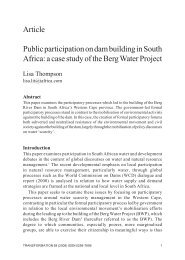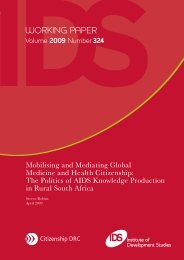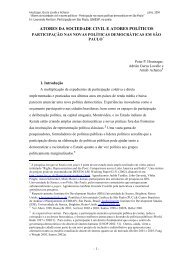Associations and the Exercise of Democratic ... - Citizenship DRC
Associations and the Exercise of Democratic ... - Citizenship DRC
Associations and the Exercise of Democratic ... - Citizenship DRC
Create successful ePaper yourself
Turn your PDF publications into a flip-book with our unique Google optimized e-Paper software.
IDS WORKING PAPER 285Table B.8 Propensity to be active for those with <strong>and</strong> withoutassociational participation after groups have been matched, SãoPaulo <strong>and</strong> Mexico CityOutcome One to one: Three nearestVariable Unmatched nearest neighbour neighbourWith Without With Without With WithoutAssociational Associational Associational Associational Associational AssociationalParticipation Participation Participation Participation Participation ParticipationSÃO PAULOActiveCitizens0.5597 0.2777 0.559 0.258 0.5601 0.2732Dem<strong>and</strong>making with 0.5 0.2425 0.5 0.2309GovernmentMEXICO CITYDem<strong>and</strong>making with 0.5683 0.3604 0.5683 0.3908GovernmentThe columns under <strong>the</strong> heading Unmatched reports <strong>the</strong> proportions that are activecitizens or that have direct relations with government. The difference in proportionsthat make up active citizens for those with associational participation <strong>and</strong> thosewithout is significant. This difference remains consistent throughout <strong>the</strong> matchingtechnique we used. We used two matching techniques: one-to-one matching <strong>and</strong>three nearest neighbourhood . In three nearest neighbourhood matching for activecitizenship, two observations are dropped from <strong>the</strong> group with associationalparticipation. In all cases <strong>the</strong> groups act differently. Thus we can confirm that <strong>the</strong>reare no selection biases in associational participation influencing citizen activities.No alternative models: What has been <strong>the</strong> result <strong>of</strong> various tests to substantiate <strong>the</strong>results reported in Tables B.1 <strong>and</strong> B.2 <strong>and</strong> correspondingly Tables 5.1 <strong>and</strong> 5.2 in <strong>the</strong>text? We believe <strong>the</strong> results for <strong>the</strong> endogeneity test show that <strong>the</strong> probit modelswhich are easier to interpret are applicable even if only for some specificationsendogeneity cannot be ruled out. Our tests do not show that we can rule outselection bias. Hence we do not interpret models o<strong>the</strong>r that those reported inTables B.1 <strong>and</strong> B.2.51





